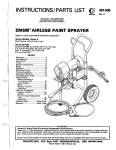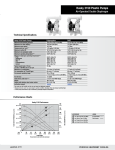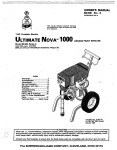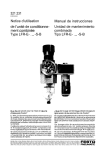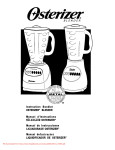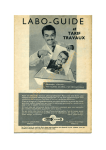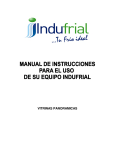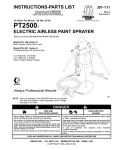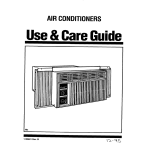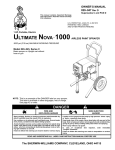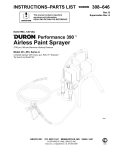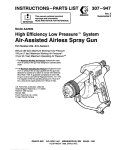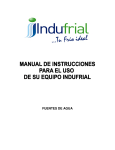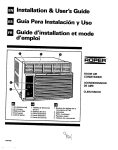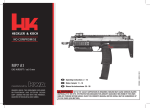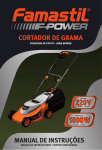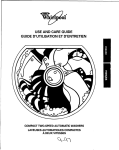Download 307460F EM 480 Hydra-Spray Portable Electric Airless
Transcript
Parts WARNING HIGH PRESSURE SPRAY CAN CAUSE SERIOUS INJURY. General Safety This equipment generates very high fluid pressure. Spray from the gun, leaks or ruptured components can inject fluid through your skin and into your body and cause extremely serious bodily injury, including the need for amputation. Also, fluid injected or splashed into the eyes can cause serious damage. NEVER point the spray gun at anyone or at any part of the body. NEVER put hand or fingers over the spray tip. NEVER try to “blow back” paint; this is NOT an air spray system. ALWAYS have the tip guard in place on the spray gun when spraying. ALWAYS follow the Pressure Relief Procedur?, . below, before cleaning or removing the spray tip or servlcrng any system equipment. NEVER try to stop or deflect leaks with your hand or body. Be sure equipment safety devices are operating properly before each use. Medical Treatment If any fluid ap ears to enetrate our skrh et EMEhENCY hEDICAi CAR6 &T ONCE. DO NOT TREAT AS A SIMPLE CUT. Tell the doctor exactly what fluid was injected. For treatment instructions, have your doctor call the NATIONAL POISON CENTEP NETWORK (412)681-6668 . ,- r Spray Gun Safety Devices Be sure all gun safety devices are operating properly before each use. Do not remove or modify any part of the gun; this can cause a malfunction and result in serious bodily injury. Safety Latch Whenever you stop spraying, even for a moment, always set the gun safety latch in the closed or “safe” position, making the gun inoperative. Failure to set the safety latch can result in accidental triggering of the gun. Diffuser The gun diffuser breaks up spray and reduces the risk of injection when the tio is not installed. Check diffuser operation regularly. Follow’ the Pressure Relief Procedure,’ below, then remove the spray tip. Aim the gun into a metal pail, holding the gun firmly to the pail. Using the lowest possible pressure, trigger the gun. If the fluid emitted Is not diffused into an irregular stream, replace the diffuser immediately. Tip Guard ALWAYS have the tip guard in place on the spray gun while spraying. The tip guard alerts you to the injection hazard and helps prevent accidentally placing your fingers or any part of your body close to the spray tip. Spray Tip Safety Use extreme caution when cleaning or changing spray tips. If the spray tip clogs while spraying, engage the gun safety latch immediately. ALWAYS follow the Pressure Relief Procedure and then remove the spray tip to clean it. NEVER wipe off build up around the spray tip until pressure is fully relieved and the gun safety latch is engaged. Pressure Relief Procedure To reduce the risk of serious bodily injury, including injection or injury from moving parts or electric shock, always follow this procedure whenever you shut off the sprayer, when checking or servicing any part of the spray system, when installing, cleaning or changing spray tips, and whenever you stop spraying. (1) Engage the gun safety latch. (2) Turn the ON/OFF switch to OFF. (3) Unplug the power supply cord. (4) Disengage the gun safety latch. (5) Hold a metal part of the gun firmly to the side of a metal pail, and trigger the gun to relieve pressure. (6) Engage the gun safety latch. (7) Open the drain valve, having a container ready to catch the drainage. (8) Leave the drain valve open until you are ready to spray again. If you suspect that the spray tip or hose is completely clogged, or that pressure has not been fully relieved after following the steps above, VERY SLOWLY loosen the tip guard retaining nut or hose end coupling and relieve pressure gradually, then loosen completely. Now clear the tip or hose. ENGAGE SAFETY 2 307460 TURN SWITCH TO OFF UNPLUG CORD DISENGAGE SAFETY AND TRIGGER GUN; ENGAGE SAFETY AGAIN OPEN DRAIN VALVE FIRE OR EXPLOSION HAZARD. General Safety Any misuse of the spray equipment or accessories, such as overpressurizing, modifying parts, using incompatible chemicals and materials, or using worn or damaged parts, can cause them to rupture and result in injection or other serious bodily injury, fire, explosion or property damage. NEVER alter or modify any part of this equipment; doing s o could cause it to malfunction. CHECK all spray equipment regularly and repair o r replace worn or damaged parts immediately. System Pressure .‘- (.l Static electricity is created by the high velocity flow of fluid through the pump and hose. If every part of the spray equipment is not properly grounded, sparking may occur, and the system may become hazardous. Sparking may also occur when plugging in or unplugging a power supply cord. Sparks can ignite fumes from solvents and the fluid being sprayed, dust particles and other flammable substances, whether you are spraying indoors or outdoors, and can cause a fire or explosion and serious bodily injury and property damage. Always plug the sprayer into an outlet at least 20 feet (6 m) away from the sprayer and the spray area. Do not plug in or unplug any power supply cords in the spray area when there is any chance of igniting fumes still in the air. This soraver can develoo 2750 osi 173J bar) MAXIMUM WORkINk PRESSURE. Be sure that ail spray equipment and accessories are rated to withstand the maximum working pressure of this sprayer. DO NOT exceed the maximum working pressure of any component or accessory used in the system. Groundin Material Corn atibility 1. plug the power supply cord, or extension cord, each equipped with an undamaged three-prong plug, into a properly grounded outlet. Do not use an adapter. All extension cords must have three wires and be rated for 15 amps. HOSE SAFETY 2. Fluid hoses: High pressure fluid in the hoses can be very dangerous. If the hose develops a pinhole leak, split or rupture due to any kind of wear, damage or misuse, the high pressure spray emitted from it can cause an injection injury or other serious bodily injury or property damage. 3. Spray gun: 4. Object 5. All solvent pails used when flushing, code. Use only metalpails, which are 6. To maintain grounding continuity when flushing or relieving pressure, always hold a metal part of the gun firmly to the side of a metal pail, then trigger the gun. To reduce tf e risk of static sparking, ground the sprayer and all other spray equipment used or located in the spray area. CHECK your local electrical code for detailed grounding instructions for your area and type of equipment. BE SURE to ground all of this spray equipment: BE SURE that alP materials and solvents used are chemically compatible with the wetted parts shown in the Technical Data on the back cover. Always read the material and solvent manufacturer’s literature before using them in this sprayer. ALL FLUID HOSES MUST HAVE SPRING GUARDS! The spring guards help protect the hose from kinks or bends at or close to the coupling which can result in hose rupture. TIGHTEN all fluid connections securely before each use. High pressure fluid can dislodge a loose coupling or allow high pressure spray to be emitted from the coupling. NEVER use a damaged hose. Before each use, check entire hose for cuts, leaks, abrasion, bulging cover, or damage or movement of the hose couplings. If any of these conditions exist, replace the hose immediately. DO NOT try to recouple high pressure hose or mend it with tape or any other device. A repaired hose cannot contain the high pressure fluid. HANDLE AND ROUTE HOSES CAREFULLY. Do not pull on hoses to move equipment. Do not use materials or solvents which are not compatible with the inner tube and cover of the hose. DO NOT expose the hose to temperatures above WOOF W°C) or below -4OOF (-4OOC). Hose Grounding Continuity The fluid hoses provided with this sprayer have electrically conductive material on the surface of the center core of the hose. Other hoses on the market may have a ground wire extending the length of the hose. The ground wire can break in use which will destroy the electrical grounding of the hose. Sprayer: use only grounded hoses with a maximum of 500 feet (150 m) combined hose length to ensure grounding continuity. Refer to Hose Grounding Continuity. obtain grounding through connection to a properly grounded fluid hose and sprayer. being sprayed: according to local code. according to local conductive. Do not place the pail on a non-conductive surface, such as paper or cardboard, which interrupts the grounding continuity. Flushin Safety Reduce ti! e risk of injection injury, static sparking, or splashing by following the specific flushing procedure given on page 9 of this manual. Follow the Pressure Relief Procedure on page 2, and remove the spray tip before flushing. Hold a metal part of the gun firmly to the side of a metal pail and use the lowest possible fluid pressure during flushing. . MOVING PARTS HAZARD’ Moving parts can pinch or body parts. KEEP CLEAR of operating the sprayer. Unplug before checking or servicing starting accidentally. amputate your fingers or other moving parts when starting or the sprayer and relieve pressure the sprayer to prevent it from To be sure of continuity, check electrical resistance at least once a week. Check overall resistance when using multiple hose assemblies. If the resistance exceeds 29 megohms, replace it immediately. Ground wire hose may have different resistance; check supplier. IMPORTANT United States Government safety standards have been adopted under the Occupational Safety and Health Act. These standards-particularly the General Standards, Part 1910, and the Construction Standards, Part 1926-should be consulted. 307460 3 A VERTISSEMENT La pulv&isation A haute pression peut causer des blessures tr&s graves. R6serv6 exclusivement & I’usage professionnel. Observer toutes les consignes de s&wit& Bien lire et bien comprendre tous les manuels d’instructions avant d’utiliser le mat6riel. Consignes g6n6rales enlever ni modifier une partie quelconque du pistolet; ceci risquerait d’entrainer un mauvais fonctionnement et des blessures graves. Verrou de s&wit& A chaque fois que I’on s’arrkte de pulveriser, mQme s’il s’agit d’un court instant, toujours mettre le verrou de securite du pistolet sur la position “fermee” ou “securite” (“safe”) pour empkher le pistolet de fonctionner. Si le verrou de securite n’est pas mis, le pistolet peut se dtklencher accidentellement. Diffuser Le diffuseur du pistolet sert B diviser le jet et a reduire les risques d’injection accidentelle quand I’ajutage n’est pas en place. Verifier le fonctionnement du diffuseur regulierement. Pour cette verification, detendre la pression en observant la Marche a Suivre pour Ddtendre la Pression donnee plus loin puis enlever I’ajutage du pulverisateur. Pointer le pistolet dans un seau en metal, en le maintenant fermement contre le seau. Puis, en utilisant la pression la plus faible possible, appuyer sur la gachette du pistolet. Si le fluide projete n’estpas diffuse sous forme de jet irregulier, remplacer immediatement le diffuseur. Protection de l’aju tage TOUJOURS maintenir la protection de I’ajutage en place sur f e pistolet du pulverisateur pendant la pulverisation. La protection de I’ajutage attire I’attention sur les risques d’injection et contribue B eviter que les doigts ou une partie quelconque du corps ne passe accidentellement B proximite immediate de I’ajutage du pulverisateur. de skuritd Cet appareil produit un fluide 8 tres haute pression. Le fluide pulverise par le pistolet ou le fluide sous pression provenant de fuites ou de ruptures peut penetrer sous la peau ou a I’interieur du corps et entrainer des blessures tres graves, voir mQme une amputation. MQme sans Qtre sous pression, le fluide bclaboussant ou entrant dans les yeux peut aussi entrainer des blessures graves. NE JAMAIS pointer le pistolet vers quelqu’un ou vers une partie quelconque du corps. NE JAMAIS mettre la main ou les doigts sur I’ajutage du pulverisateur. NE JAMAIS essayer de “refouler” la peinture. Cet appareil N’est PAS un compresseur pneumatique. TOUJOURS garder la protection de I’ajutage en place sur le pistolet pendant la pulverisation. TOUJOURS observer la March g Suivre pour D6tendre la Pression don&e plus loin, avant de nettoyer ou d’enlever I’ajutage du pulverisateur, ou d’effectuer un travail quelconque sur une partie de I’appareil. NE JAMAIS essayer d’arrQter ou de devier les fuites avec la main ou le corps. Avant chaque utilisation, bien s’assurer que les dispositifs de securite fonctionnent correctement. Soins mddicaux En cas de pen&ration de fluide sous la peau: DEMANDER IMMEDIATEMENT DES SOINS MEDICAUX D’URGENCE. NE PAS SOIGNER CE7TE BLESSURE COMME UNE SIMPLE COUPURE. Dire exactement au medecin quel type de liquide a 6te inject& Pour avoir des instructions concernant le traitement approprie, dire au medecin d’appeler le CENTRE ANTI-POISON SUIVANT: NATIONAL POISON CENTER NETWORK Consianes de skurit4 concernant I’ajutage du pulvklsateur Faire extramement attention B l’occasion du nettoyage ou du remplacement des ajutages du pulverisateur. Si l’ajutage se bouche pendant la pulverisation, mettre immediatement le verrou de securite du pistolet. TOUJOURS bien observer la Marche g Suivre pour Ddtendre la Pression puis enlever I’ajutage du pulverisateur pour le nettoyer. NE JAMAIS essuyer ce qui s’est accumule autour de I’ajutage du pulverisateur avant que la pression ne soit completement tombee et que le verrou de securite du pistolet ne soit engage. (412)681-6669 Avant chaque utilisation, bien s’assure que tous les dispositifs de securite du pistolet fonctionnent correctement. Ne pas Marche A Suivre pour D6tendre la Pression Pour reduire les risques de blessures graves, y compris les blessures par injection de fluide ou celles causees par des pieces en mouvement ou par electrocution, toujours bien observer cette marche a suivre B chaque fois que I’on arrQte le pulverisateur, B I’occasion de la verification ou de la reparation d’une piece de I’appareil de pulverisation, 8 I’occasion de I’installation, du nettoyage ou du remplacement des ajutages et d’une man&e g&n&ale a chaque arr9t. 1) Engager le verrou de securite du pistolet. 2) Mettre I’interrupteur Marche-Arrat sur ARRET (“OFF”). 3) Debrancher le cordon d’alimentation. 4) Desengager le verrou de securite du pistolet. 5) En maintenant une partie metallique du pistolet fermement appuyee contre le c&e d’un seau en metal, appuyer sur la gachette du pistolet pour liberer la pression. 6) Engager le verrou de securite du pistolet. 7) Ouvrir le robinet de purge en prenant soin d’avoir un recipient prQt B recuperer le liquide. 8) Laisser le robinet de purge ouvert jusqu’a ce que le pulverisateur soit de nouveau prQt a &re utilise. Sil’on soupconne que l’ajutage du pulvkisateur ou le tuvau est complktement bouchh, ou que la pression n’a pas BttS complktement lib&&e apr&s avoir proc&d& aux opkrations ci-dessus, desserrer TRES LENTEMENT l’ecrou de retenue de la protection de I’ajutage ou le raccord du bout du tuyau et liberer progressivement la pression, puis terminer le desserrage. On peut maintenant debaucher I’ajutage ou le tuyau. MA 1 2 3 ‘L&6 7 RISQUES EN CAS DE MAUVAISE UTILISATION DU MATERIEL Consignes g6n&ales de skurit4 Pression Toute utilisation anormale de I’appareil de pulverisation ou des accessoires comme, par exemple, la mise sous une pression excessive, les modifications de pieces, I’utilisation de produits chimiques et de matieres incompatibles et I’utilisation de pieces us&es ou abimees peut causer des deg&s B I’appareil ou des ruptures de pieces et entrainer une injection de liquide ou d’autres blessures serieuses, un incendie, une explosion ou d’autres degats. Ce pulverisateur peut produire une PRESS/ON MAXIMUM DE TRAVAIL l&W bar 12750 lb/po.2). S’assurer que tous les elements du pulverisateur et ses accessoires sont concus pour resister a la pression maximum de travail de ce pulverisateur. NE PAS depasser la pression maximum de travail d’aucun des elements ou accessoires utilises avec cet appareil. NE JAMAIS alterer ou modifier une piece de cet appareil; ceci risquerait d’entrainer son mauvais fonctionnement. VERIFIER regulierement tout I’appareil de pulverisation et ses equipements et &parer ou remplacer immediatement les pieces u&es ou abimees. MESURES DE SECURITE TOUS LES TUYAUX FLEXIBLES DOIVENT AVOIR DES RESSORTS SPIRALE DE PROTECTION! Les spirales de protection contribuent 8 eviter la formation de pliures, de boucles ou de noeuds sur les tuyaux qui pourraient entrainer la rupture du tuyau 8 I’endroit du raccord ou a son voisinage. SERRER FERMEMENT tous les raccords avant chaque utilisation. Le fluide sous pression peut faire sauter un raccord desserre ou produire un jet a haute pression s’echappant par le raccord. NE JAMAIS utiliser un tuyau endommage. Avant chaque utilisation, verifier entierement chaque tuyau pour deceler les coupures, fuites, abrasions, boursouflures de I’enveloppe ou toute autre deterioration ou jeu des raccords. Si I’on constate I’une de ces deteriorations, il faut remplacer le tuyau immediatement. NE PAS essayer de refaire le raccord d’un tuyau haute pression ni de reparer le tuyau avec du ruban adhesif ou D’INCENDIE OU BIEN S’ASSURER que tous les corps des solvants utilises sont chimiquement compatibles avec les parties mouilkes indiquees dans les “Donnees techniques”, au dos de la couverture. Toujours lire soigneusement les documents et brochures du fabricant des mat&es et solvants utilises avant de s’en servir dans ce pulverisateur. CONCERNANT LES T U Y A U X Le fluide a haute pression circulant dans les tuyaux peut &re tres dangereux. En cas de fuite sur le tuyau, mQme minuscule, de fissure, dechirure ou rupture a la suite de I’usure, de degfits ou d’une mauvaise utilisation, les projections de fluide haute pression qui en proviennent peuvent entrainer des blessures graves par penetration sous la peau ou par contact, ainsi que des deggts materiels. RISQUES Compatibilit4 chimique des corps FLEXIBLES par tout autre moyen. Un tuyau repare ne peut pas resister au fluide sous pression. MANIPULER L E S T U Y A U X A V E C P R E C A U T I O N E T CHOISIR SOIGNEUSEMENT LEUR CHEMIN. Ne pas deplacer le materiel en tirant sur le tuyau. Ne pas utiliser de mat&es ou de solvants qui ne sont pas compatibles avec I’enveloppe interieure ou exterieure du tuyau. NE PAS exposer le tuyau a des temperatures superieures a 82°C (18OOF) ou inferieures a -40°C (-4OOF). Continuitd du circuit de mise A la terre des tuyaux Les tuyaux flexibles fournis avec ce pulverisateur ont une surface conductrice continue au coeur du tuyau. D’autres tuyaux vendus dans le commerce cornportent un fil de mise a la terre allant tout au long du tuyau. Ce fil de mise a la terre peut se rompre a I’usage, ce qui supprime la mise a la terre du tuyau. Pour &re certain de la continuite de la mise a la terre, il faut verifier la resistance Blectrique des tuyaux au moins une fois par semaine. Verifier aussi la resistance d’ensemble quand il y a plusieurs tuyaux assembltk Si la resistance depasse 29 megohms, remplacer immediatement le tuyau. La resistance des tuyaux mis a la terre par un fil peut Qtre differente; se renseigner aupres du fournisseur. \ D’EXPLOSION De l’electricite statique est produite par le passage du fluide a grande vitesse dans la pompe et dans les tuyaux. Si toutes les pieces de I’appareil de pulverisation ne sont pas convenablement reliees a la masse ou B la terre, des etincelles peuvent se produire et I’appareil risque d’9tre dangereux. Des Btincelles peuvent egalement se produire a I’occasion du branchement ou du debranchement du cordon d’alimentation. Les etincelles sont suffisantes pour allumer les vapeurs de solvants et le fluide pulverise, les fines particules de poussiere ainsi que d’autres substances inflammables, quand on pulverise a I’interieur ou 8 I’exterieur, et elles peuvent causer un incendie ou une expiosion, ainsi que des blessures graves et des deggts materiels. Toujours brancher le pulverisateur dans une prise se trouvant a au moins 6 m (20 pieds) de I’appareil et de I’endroit oti se fait la pulverisation. Ne pas brancher ou debrancher un cordon d’alimentation quel qu’il soit dans la zone ou se fait la pulverisation quand il y a le moindre risque que des vapeurs encore presentes dans I’air prennent feu. Mise & la terre ou A la masse Pour reduire les risques de production d’etincelles d’electricite statique, le pulverisateur et tous les equipements utilises ou se trouvant dans la zone de pulverisation doivent Qtre relies a la terre ou a la masse. Pour connaitre le detail des instructions de mise ZI la terre dans la region et le type particulier d’equipement, CONSULTER le code ou les reglementations electriques locales. S’ASSURER que tous les equipements de pulverisation suivants sont bien relies a la terre: 1. Pulwkisateur: Brancher le cordon d’alimentation ou la rallonge qui doivent Qtre equip& d’une prise 8 3 fiches en bon &at, dans une prise de courant convenablement mise a la terre. Ne pas utiliser d’adaptateur. Toutes les rallonges doivent avoir 3 fils et &re prevues pour 15 amperes. ;. 2. Tuyaux flexibles: Afin d’assurer la continuite de la mise a la terre, n’utiliser que des tuyaux comportant une mise a la terre e t a y a n t u n e l o n g u e u r m a x i m u m combinee d e 1 5 0 m (1500 pieds). Se reporter egalement au paragraphe “Con- tinuitb du circuit de mise A la terre des tuyaux”. 3. Pistolet: Realiser la mise 8 la terre en le raccordant a un tuyau flexible et a un pulverisateur deja convenablement relies a la terre. 4. Objets, mattkiel ou surfaces recevant la pulv&isation: observer le code ou les reglementations locales. 5. Tous /es seaux de so&ants utilises pour le rincage: observer le code ou les reglementations locales. N’utiliser que des seaux m&a//iques conducteurs de l’electricite. Ne pas mettre le seau sur une surface non conductrice comme sur du papier ou du carton car cela interromprait la continuite le la mise a la terre. 6. Pour conserver la continuith de la mise B la terre quand on rince le matkriel ou quand on lib&e la pression, toujours maintenir une partie metallique du pistolet fermement appuyee contre le cot& d’un seau en m&a/ puis appuyer sur la detente du pistolet. Mesures de Sdcurit4 concernant le Rincage Pour reduire les peau et les risques aux eclaboussures, donnee a la page risques de blessures par penetration de la dirs aux etincelles d’electricite statique ou observer la marche a suivre pour le rincage 9 de ce manuel. Observer la “Marche & Suivre pour Dbtendre la Pression” donnee a la page 4 en enlever l’ajutage du pulv&isateur avant le rincage. Maintenir une partie metallique du pistolet fermement appuyee contre le tote d’un seau en m&al et utiliser la pression la plus faible possible pendant le rincage. 307460 5 ADVERTENCIA EL ROCIADO A ALTA PRESION PUEDE CAUSAR GRAVES LESIONES. SOLO PARA US0 PROFESIONAL. RESPETE LOS AVISOS DE ADVERTENCIA. Lea y entienda todo el manual de instrucciones antes de manejar el equipo. PEUGRO DE Iff YECCION DE FLUID0 Seguridad general Aparatos de seguridad de la pistola pulverizadora Este equip0 genera un fluid0 a una presion muy alta. El rociado de la pistola, 10s escapes de fluid0 o roturas de 10s componentes pueden inyectar fluid0 en la piel y el cuerpo y causar lesiones extremadamente graves, incluyendo a veces la necesidad de amputacibn. Tambien, el fluid0 i n y e c t a d o o salpicado en 10s ojos puede causar graves dafios. Asegurar que todos 10s aparatos protectores de la pistola estan f u n c i o n a n d o b i e n a n t e s d e cada u s o . N o sacar n i modificar ninguna pieza de la pistola pues podria causar el malfuncionamiento de la misma con las consiguientes lesiones personales. NUNCA apuntar la pistola hacia alguien o alguna parte del cuerpo. NUNCA colocar la mano o 10s dedos encima de la boquilla. NUNCA tratar de “hater retornar la pintura”; este NO es un sistema de rociado de aire. Cada vez que se deje de pulverizar, aunque sea por un breve momento, siempre colocar el pestillo de seguridad en la position “cerrada”, lo que deja la pistola inoperante. El no hacerlo puede llevar al disparo imprevisto de la pistola. SIEMPRE tener colocado el protector de la boquilla en la pistola mientras se esta pulverizando. Difusor Pestillo de segut-idad Asegurar que todos 10s aparatos de seguridad del equip0 estan funcionando bien antes de cada uso. El difusor de la pistola dispersa el chorro pulverizado y reduce el riesgo de inyeccion cuando no esta instalada la boquilla. Revisar con regularidad el funcionamiento del difusor. Seguir el procedimiento de descarga de presibn, dado mas abajo, y despues sacar la boquilla. Apuntar la pistola a un balde metalico, sosteniendola bien firme contra 61. Utilizando la presion m&r bajo posible, disparar la pistola. Si el fluid0 emitido no sale disperse en un chorro irregular, reemplazar de inmediato el difusor. Tratamiento medico Protector de la boquilla SIEMPRE seguir el procedimiento de descarga de presibn, dado m& abjo, antes de limpiar o sacar la boquilla o de dar servicio a cualiquier equip0 del sistema. NUNCA tratar de parar o desviar 10s escapes con la mano o el cuerpo. SIEMPRE tener el protector de ia boquilla colocado en la pistola mientras se esta pulverizando. Este protector llama la atencion contra el peligro de inyeccibn y ayuda a prevenir la colocacion accidental de 10s dedos o cualquier otra parte del cuerpo cerca de la boquilla. Si pareciera que un poco de fluid0 penetro la piel, conseguir TRATAMIENTO MEDICO DE URGENCIA DE INMEDIATO. NO TRATAR LA HERIDA C O M O U N S I M P L E C O R T E . Decir al medico exactamente cua fluid0 fue. Para instrucciones de tratamiento, pedir al medico que llame a la CADENA DEL CENTRO NACIONAL DE ENVENENAMIENTO Seguridad de la boquilla pulverizadora Tener mucho cuidado al limpiar o cambiar las boquillas. Si llegara a obstruirse mientras esta pulverizando, enganchar el pestillo de la pistola de inmediato. SIEMPRE seguir el procedimiento de descarga de presih y despues sacar la boquilla para limpiarla. NUNCA limpiar la acumulacion de pintura alrededor de la boquilla antes de que se haya descargado por complete la presion y el pestillo este enganchado. Procedimiento de descarga de presih Para reducir el riesgo de sufrir graves lesiones corporales, rncluyendo inyeccion o lesiones causadas por piezas en movimiento o choque electrico, siempre seguir este procedimiento al apagar la maquina pulverizadora, al revisar o dar servicio a cualquier parte del sistema de pulverizacibn, al instalar, limpiar o cambiar las boquillas, y cada vez que se deja de pulverizar. (1) Enganchar el pestillo de la pistola. (2) Mover el interruptor electrico (ON/OFF) a la position OFF (apagado). (3) Desenchufar el cordon ektrico. (4) Desenganchar el pestillo de la pistola. (5) Sujetar una parte mettilica de la pistola bien firme contra un balde de metal, y disparar la pistola para descargar la presibn. (6) Enganchar el pestillo de la pistola. (7) Abrir la valvula de drenaje y tener listo un reclipiente para recibir la pintura. (8) Dejar la valvula de drenaje abierta hasta que se este nuevamente listo para pulverizar. Sise sospecha que la boquilla o la manguera est4 completamente obstruida, o que no se ha descargado por complete la presidn despuh de haber seguido elprocedimiento anterior, aflojar MUY LENTAMENTE la tuerca de retention del protector de la boquilla o acoplamiento de la punta de la manguera y descargar gradualmente la presibn, despues, aflojarlo por complete. Luego, despejar la boquilla o la manguera. 1 6 307460 2 3 456 7 PELIGRO POR MAL US0 DEL EQUIP0 PELIGRO DE INCENDIO 0 EXPLOSIOhl Seguridad eneral El flujo a alta velocidad del fluid0 al pasar por la bomba y manguera crea electricidad estatica. Si todas las partes del equip0 pulverizador no tienen buena tierra, pueden ocurrir chispas, convirtiendo al sistema en algo peligroso. Tambien, pueden producirse chispas al enchufar o desenchufar el cordon electrico. Estas chispas pueden inflamar 10s vapores de 10s solventes y el chorro de fluid0 pulverizado, particulas de polvo y otras sustancias inflamables, sea al aire libre o bajo techo, lo que podria causar una explosion o incendio y graves lesiones corporales y dafios a la propiedad. Enchufar siempre la pulverizadora a un tomacorriente que se encuentre a por lo menos 6 m (20 pies) de la maquina y del area que se va a rociar. No enchufar o desenchufar ningun cordon electrico en el lugar donde se esta rociando cuando todavia exista la posibilidad de que queden vapores inflamables en el aire. Cualquier ma Buso del equip0 pulverizador o 10s accesorios, tal coma sobrepresurizacion, modificacibn de piezas, uso de materiales y productos quimicos incompatibles, o utilization de piezas dafiadas o desgastadas, puede hacen que se rompan y causen la inyeccion de fluid0 u otras lesiones corporales graves, incendio, explosion o dafion a la propiedad. NUNCA alterar o modificar ninguna p i e z a de este equipo; el hacerlo podria causar una averia. REVISAR con regularidad el equip0 pulverizador y reparar o reemplazar de inmediato las piezas dafiadas o desgastadas. Presi6n del sistema E s t a p u l v e r i z a d o r a p u e d e d e s a r r o l l a r 1 9 0 b a r i a s (2756 psi) de PRESION DE TRABAJO MAXIMA. Asegurar que todo el equip0 pulverizador y sus accesorios tienen la capacidad para a g u a n t a r l a presibn m a x i m a d e t r a b a j o d e esta pulverizadora. NO exceder la presion maxima de trabajo de ningun componente o accesorio de este sistema. Compatibilidad de material ASEGURAR que todos 10s materiales y solventes usados son quimicamente compatibles con las piezas mojadas ilustradas en la hoja de datos tecnicos en la contratapa. Siempre leer las instrucciones del fabricante del material y solvente antes de usarlos en esta pulverizadora. SEGURIDAD EN EL US0 DE LAS MANGUERAS El fluid0 que pasa a alta presion por las mangueras puede ser muy peligroso. Si en la manguera se desarrolla un escape pequefio, una rotura o rajadura debido a cualquier tipo de desgaste, daiio o maltrato, el chorro a alta presion emitido por alli puede causar una lesion por inyeccion u otras lesiones corporales graves o dafion a la propiedad. iTODAS L A S M A N G U E R A S PARA FLUIDOS TIENEN QUE TENER GUARDAS DE RESORTE! Estas protegen las mangueras contra dobleces o retorceduras en 10s acoplamientos o cerca de ellos, 10s que podrian traducirse en roturas de la manguera. Antes de usarlas, APRETAR bien firmes todas las conexiones. El fluid0 a alta presion puede desalojar un acoplamiento suelto o dejar que por &I escape un chorro a alta presibn. NUNCA usar una manguera que esta daiiada. Siempre, revisarla en busca de cortaduras, escapes, abrasion, cubierta abultada, o acoplamientos sueltos o dafiados. Si llegara a encontrarse cualquiera de estas condiciones, reemplazar de inmediato la manguera. NO intentar reacoplar una manguera de alta presion o enmendarla con cinta adhesiva u otro material similar. Una manguera que ha sido remendada no aguante el fluid0 a alta presion. MANEJAR Y P A S A R CUIDADOSAMENTE L A S MANGUERAS. No tirar de las mangueras para mover el equipo. No usar materiales o solventes que Sean incompatibles con el tubo interno y la cubierta dela manguera. NO exponer las mangueras a temperaturas sobre 82°C (180°F) o bajo -40°C (-40°F). Continuidad a tierra de la manguera Las mangueras para fluidos provistas con esta pulverizadora tienen material electricamente conductive en la superficie del nlicleo central. Otras mangueras a la venta tienen a veces un alambre a tierra a todo el largo. Este alambre puede romperse con el uso, destruyendose por lo tanto, la conexion a tierra de la manguera. Corn0 precaution, revisar por lo menos una vez a la semana la resistencia electrica. Revisar la resistencia general al usar conjuntos de mangueras multiples. Si excede de 29 megaohmios, reemplazarla de inmediato. Las mangueras con alambre a tierra tienen diferentes resistencias; consultar con el proveedor. Puesta a tierra Para reducir el riesgo de chispas estaticas, conectar a tierra la pulverizadora y todo el otro equip0 de pulverizar que se use o se encuentre en el lugar que se va a rociar. CONSULTAR el cddigo electrico de la localidad para las instrucciones sobre las conexiones a tierra exigidas para la zona y tipo de equipo. A S E G U R A R d e c o n e c t a r a t i e r r a todo e s t e equip0 pulverizador: 1. Pulverizadora: enchufar el cordon electrico, o cable extensor, cada uno con un enchuf de tres patas en buen estado, a un tomacorriente con puesta a tierra apropiado. No usar un adaptador. Totos 10s cables extensores tienen que tener tres hilos y una capacidad de 15 amperios. 2. Mangueras para fluidos: usar solamente mangueras con puesta a tierra de una longitud combinada de 150 m KiOO pies), para asegurar buena continuidad a tierra. Referirse tambien a l parrafo sobre c o n t i n u i d a d a t i e r r a d e l a manguera. 3 . Pistola: hater l a p u e s t a a t i e r r a conectandola a una manguera de fluid0 y pulverizadora bien conectadas a tierra. 4. Objet0 que se estA rociando: d e conformidad local. con el cbdigo 5. Todos /OS baldes de solvente usados durante el lavado, de conformidad con el cbdigo local. Usar solamente baldes de metal, que Sean conductivos. No colocar el balde en una superficie no conductiva, coma papel o carton, que interrumpe la continuidad a tierra. 6. Para mantener la continuidad a tierra durante ei lavado o descarga de presih, siempre apoyar una parte metalica de la pistola bien firme contra el costado del balde de metal, despues apretar el gatillo. Seguridad durante el lavado Reducir el riesgo de lesiones por inyeccion, chispas electricas s i g u i e n d o e l p r o c e d i m i e n t o d e lavado o salpicaduras, especifico dado en la pagina 9 de este manual. Seguir el procedimiento de descarga de presibn en la pagina 6, y quitar la boquilla rociadora antes de lavar. Apoyar una parte metalica de la pistola bien firme contra el costado de un balde de metal y usar la presion mas baja posible de fluid0 durante el lavado. PELIGRO DE LAS PIEZAS MOVILES Las piezas en movimiento pueden pinchar o amputar dedos u otras partes del cuerpo. MANTENERSE ALEJADO de las piezas en movimiento durante el arranque o funcionamiento de la pulverizadora. Desenchufar la pulverizadora y descargar la presion antes de revisarla o darle servicio, para impedir que arranque inesperadamente. IMPORTANT Se han adoptado las normas de seguridad del gobierno de 10s Estados Unidos de Norteamerica bajo el Acta de Seguridad y Salud Ocupacional. Deberan consultarse estas normas, en especial las Generales, Parte 1910, y las Normas de Construccibn, Parte 1926. 307-460 7 .’ INSTALLATION , ” .’ \ I : .’ .: I,:!. I . . , ,, . :. r ON/OFF switch Check the Gearcase Oil Remove the fill plug (A) and ensure that the oil level is up to the fill plug opening. See Fig 1. Fill Packing Nut/Wet Cup Fill the packing nut/wet cup (38) l/3 full with Grace Throat Seal Liquid (TSL) to help protect and prolong the life of the pump’s throat packings. Ei;;k Electrical Service and Plug In Power Supply Be sure the electrical service is 120 V, 60 HzAc, 15 Amp (minimum) and that the outlet you use is properly grounded. Use an extension cord which has 3 wires of 12 gauge (minimum) size and a maximum of 100 ft (30.3 m) long. Longer lengths may affect sprayer performance. Connect the Gun Remove the plastic cap plug from the filter (64) and connect the 50 ft (15 m) spray hose (67) to the l/4 npsm(m) filter outlet (B). Then connect the whip end hose (68) between the spray hose and the fluid inlet (C) of the gun. Do not use thread sealer. Do not install the spray tip yet; wait until after flushing the sprayer. The longer the spray hose, the lower the delivery rate. Plug in the Sprayer Be sure the ON/OFF switch is OFF. Refer to Fig 1. Then plug the cord into a grounded electrical outlet at least 20 ft (6 m) away from the spray area. CAUTION To avoid damaging the pressure control, which may result in poor sprayer performance, follow these precautions: 1. Always use nylon spray hose at least 50 ft (15.2 m) long. 2 . Never use wire braid hose at it is too rigid to act as a pulsation dampener. 3 . Never install any shutoff device between the filter and the main hose. See Fig 1. 4. Never plug the main filter outlet while the sprayer is operating. 8 307460 WARNING 4 To reduce the risk of static sparking, be sure to read and follow the grounding instructions given on page 3 of this manual. Set Pressure Control Turn the pressure control knob (D) counterclockwise to the lowest setting each time before you start the sprayer to help prolong the pump life. \ Flush the Pump An important part of the care and maintenance of your EM 480 is proper flushing. See “Flushing Guidelines” on page 9 for “When to Flush” and “How to Flush”. FLUSHING GUIDELINES When To Flush . 4. Whenever you change from oil-based to waterbased paint. Flush with mineral spirits, then soapy water, followed by a clean water rinse. 1. Before using your new sprayer. Your new EM 480 was factory tested in No. 10 motor oil and the oil was left in it to protect the parts. Before using water-based paint: Flush out the oil with mineral spirits, then flush out the mineral spirits with soapy water followed by a clean water rinse. Before using o&based paint: Flush out the oil with mineral spirits only. 5. Before you store your sprayer. When using water-based paint: Flush with water, then mineral spirits and leave the pump, hose, and gun filled with mineral spirits. When using o&based paint: Flush with mineral spirits and leave the pump, hose, and gun filled with mineral spirits. 2. Whenever you change the color of your paint supply. Flush with a compatible solvent such as mineral spirits or water. 6. Before you use your sprayer after storage. Before using water-based paint: Flush out mineral spirits with soapy water followed by a clean water rinse. Before using o&based paint: Flush the mineral spirits out and the unit is ready to use. . .; .’: <> 3. Whenever you change from water-based to oilbased paint. Flush with soapy water, then mineral spirits. How To Flush 1. Follow the Pressure Relief Procedure Warning on page 2, then remove the spray tip. \ WARNING To reduce the risk of an injection injury, always remove the spray tip from the gun before flushing. 2. Remove the filter bowl and screen. See manual 307-273, supplied. If the bowl is tight, remove the filter assembly from the sprayer first. Install the bowl on the filter without the screen. Clean the screen separately. CAUTION Using excessive force to remove the filter bowl while still on the sprayer could rotate the pressure control fittings and damage the bourdon tube. 3. \ Pour l/2 gallon (2 liters) of compatible solvent (see “When to Flush”) into a bare metal pail. Put the pump suction tube in the pail. 4. Be sure the pressure control knob is set at minimum, then disengage the gun safety latch. Fig 2 8. Check all fluid connections for leaks. If there are any leaks, follow the Pressure Relief Procedure Warning, above, then tighten the connections. Start the sprayer again and check to be sure the leaking has stopped. 9. Remove the suction tube from the pail. Disengage the gun safety latch and trigger the gun into a metal pail to force solvent from the hose. Do not let the pump run dry for more than 30 seconds to avoid damaging the pump packings! When you are flushing or relieving pressure, ALWAYS hold a metal part of the gun firmly to a the risk of static sparking, which can cause fire or 5. 6. Point the spray gun into the metal pail, squeeze the trigger, turn the sprayer to ON, and slowly turn the pressure control setting clockwise just until the sprayer starts. Always use the lowest possible pressure. Keep the gun triggered until clean solvent comes from the nozzle. Release the trigger. Then open the filter drain valve, which is connected to a drain valve, and flush again to remove paint from the drain tube. 7. Release the trigger and engage the gun safety latch. Close the drain valve. 1 0 . Engage the gun safety latch, turn the sprayer to OFF, and unplug the sprayer. Open the drain valve. 1 1 . Unscrew the filter bowl (F) and reinstall the screen (G) so the stud of the filter support (H) protrudes through the end of the screen. Install the spring (E) on the stud, and reinstall the bowl, hand tight only. Be careful not to rotate or jar the pressure control fittings. 12. If you flushed with mineral spirits and are going to use a water-based paint, you must flush again with soapy water, followed by a clean water rinse. 307460 9 Prepare the Paint Prepare the paint as instructed by the manufacturer. If the paint has been opened before, remove any skin that has formed. Stir the paint thoroughly to dissolve any hard pigments. Strain the paint through a fine nylon mesh bag (available at most paint dealers) to remove particles that might clog the filter or the spray tip. This is probably the most important step toward trouble-free spray painting. Xeaning WARNING To reduce the risk of an injection injury, DO NOT hold your hand, body, or a rag in front of the spray tip when cleaning or checking a clogged tip. Always point the gun toward the ground or into a waste container when checking to see if the tip is clear. DO NOT try to “blow back” paint; this is NOT an air spray sprayer. DO NOT wipe build up off of the gun or tip until pressure is relieved. See The Pressure Relief Procedure Warning, below. Prime the Sprayer Plug the power supply cord into a grounded, 3-prong outlet. Close the drain valve. Put the paint suction tube into the pail of paint. Don’t install the spray tip in the gun yet! Disengage the gun safety latch and point the gun into a metal waste container. Squeeze the gun trigger, turn the ON-OFF switch to the ON position and let the sprayer operate until all air is forced out of the system. Engage the gun safety latch. NOTE: Clean out the front of the spray tip frequently during the day’s operation and at the end of the work day. Always relieve pressure according to the Pressure Relief Procedure Warning, below. Then use a solvent soaked brush to clean the spray tip and to keep material build up from drying and clogging the spray tip. If the pump is hard to prime, turn on the sprayer and open the drain valve. Let the sprayer run until paint has filled the drain tube (21). This method bleeds the air from the pump. Then release the gun safety latch and trigger the spray gun to prime the hose. Engage the gun safety latch. If the spray tip clogs while spraying, release the spray gun trigger, engage the gun safety latch, and turn the Reverse-A-Clean handle 18OO. See Fig 4. Disengage the gun safety latch and trigger the gun. Fluid pressure should force the obstruction from the spray tip. Release the trigger, engage the gun safety latch, return the handle to the original position, and resume spraying. Install the Spray Tip and Tip Guard Follow the Pressure Relief Procedure Warning, below. Unscrew the retaining nut from the gun. Install the Reverse-A-Clean III (90) spray housing with the tip installed (see instruction manual 307321 or the instruction label with the Reverse-A-Clean). Then tighten the Reverse-A-Clean retaining nut by hand until snug. Finally, use a wrench and tighten the retaining nut l/4 turn. This is essential to prevent leaking. ROTATE HANDLE 180” Fig 4 Shutdown and Care of the Sprayer For information about your airless gun, see instruction manual 307633. WARNING Adjust the Spray Pattern Adjust the pressure control knob (D) so the fluid pressure completely atomizes the spray from the gun. Always use the lowest possible pressure to get the desired results. See Fig 3. Now test the spray pattern on a piece of light colored paper. The tip position determines the direction of the pattern width. To adjust the pattern, engage the gun safety latch and loosen the retaining nut to position the tip so the groove is horizontal for a horizontal pattern or vertical for a vertical pattern. Once positioned, tighten the retaining nut. Fig 3 10 3 0 7 4 6 0 and Clearing the Spray Tip / Pressure Relief Procedure To reduce the risk of serious bodily injury, including injection or injury from moving parts or electric shock, always follow this procedure whenever you shut off the sprayer, when checking or servicing any part of the spray system, when installing, cleaning or changing spray tips, and whenever you stop spraying. 1 . Engage the gun safety latch. 2 . Turn the ON/OFF switch to OFF. 3 . Unplug the power supply cord. 4 . Disengage the gun safety latch. 5 . Hold a metal part of the gun firmly to the side of a metal pail, and trigger the gun to relieve pressure. 6 . Engage the gun safety latch. 7. Open the drian valve, having a container ready to catch the drainage. 8 . Leave the drain valve open until you are ready to spray again. If you suspect that the spray tip or hose is comple tely clogged, or that pressure has not been fully relieved after following the steps above, VERY SLOWLY loosen the tip guard retaining nut or hose end coupling and relieve pressure gradually, then loosen completely. Now clear the tip or hose obstruction. Before each use, squirt one drop of oil onto the lower pivot point (J) of the pump (33). See Fig 5. For very short shutoff periods, relieve pressure, leave the suction tube in the paint and clean the front of the spray tip. Check the packing nut/wet cup (38) before each use and periodically when in use. Follow the Pressure Relief Procedure Warning before checking or tightening. The packing nut should only be tight enough to stop leakage. Do not over tighten. Overtightening may cause binding and excessive wear on the packings. Clean the outlet filter often and whenever the sprayer is stored. On the last workday of the week, flush all the paint out of the sprayer. See “Flushing Guidelines,’ on page 9. If you are using a paint that will dry overnight, flush the sprayer daily at shutdow’h. Always push the suction tube onto the clip (13) on the side of the frame (6) and wrap the hose around the sprayer when storing it, even if only overnight, to help protect the hose from damage. Do not store the sprayer with water in it. Even for overnight storage, you should fill the sprayer with mineral spirits. This prevents rust and greatly extends the life of the sprayer. CAUTION Do not let water freeze in the pressure control or pump in cold weather. Freezing could cause a change in the pressure control calibration or stripping of gears, resulting in loss of pressure or stallina. Fig 5 Once a month, lubricate the needle bearing (36) in the displacement rod (34); use a grease gun to apply the grease to the grease fitting (35). See Fig 5. Periodically, or if the motor overheats, unplug the power supply cord, follow the Pressure Relief Procedure Warning on page 10, and clean all paint and dirt off the motor. Change the gearcase oil at least once a year, using Grace Gear Oil no. 206-230. The gearcase holds 3 pints (1.4 liters). Don’t use hypoid grease. 3 0 7 4 6 0 11 This guide will help you identify the causes and solutions to sprayer problems. If you cannot identify and resolve the problem, or if “Return for repair” is indicated, contact your nearest authorized service agency for instructions on where and how to return the sprayer for repair. NOTE: Reference letters in parentheses in the Troubleshooting Guide refer to the notes on page 13. WARNING Pressure Relief Procedure To reduce the risk of serious bodily injury, including injection or injury from moving parts or electric shock, always follow this procedure whenever you shut off the sprayer, when checking or servicing any part of the spray system, when installing, cleaning or changing spray tips, and whenever you stop spraying. 1 . Engage the gun safety latch. 2. Turn the ON/OFF switch to OFF. 3 . Unplug the power supply cord. 4. Disengage the gun safety latch. 5 . Hold a metal part of the gun firmly to the side of a metal pail, and trigger the gun to relieve pressure. 6 . Engage the gun safety latch. 7. Open the drain valve, having a container ready to catch the drainage. 8 . Leave the drain valve open until you are ready to spray again. If you suspect that the spray tip or hose is compie tely clogged, or that pressure has not been fully relieved after following the steps above, VERY SLOWLY loosen the tip guard retaining nut or hose end coupling and relieve pressure gradually, then loosen completely. Now clear the tip or hose obstruction. PROBLEM CAUSE SOLUTION I. Electric motor won’t operate 1. Power cord unplugged or damaged, or building circuit fuse blown 2. Motor thermal overload switch has opened. 3. Pressure setting too low 4. Damaged extension cord 5. Motor capacitor failure (b) 6. Pressure control damaged by freezing (c) or overpressurizing (d) 7. Material or water hardened in sprayer (cl. 8. Electric motor burned out 9. ON/OFF switch failure lO.Triac failure 1. Check, reset or replace. Ii. Electric motor stops while spraying II. Electric motor runs, but output low (See Problem VII also) 12 3 0 7 4 6 0 1. Power cord unplugged, or building circuit fuse blown 2. Pressure setting too low 3. Tip or filter plugged 4. Pressure control, motor capacitor (a), or motor failure 1. 2. 3. 4. Piston ball check not seating Piston packings worn or damaged Intake valve ball check not seating Displacement pump frozen (c) or drive assembly damaged 5. Pressure control frozen (c) or damaged by over-pressurization IdI 2. Unplug sprayer; cool (a). 3. 4. 5. 6. Increase. Replace. Replace. See page 15. Replace. See page 16. 7. Thaw, try to start; return for repair if needed. 8 . Replace. See page 15. 9 . Replace. 10. Replace. 1. Check, reset or replace. 2 . Increase. 3. Remove and clean. 4. Repair or replace. 1. 2. 3. 4. Repair. See page 14. Replace. See page 14. Repair. See page 14. Thaw; restart; return for repair if needed. 5. Thaw; restart; return for repair if needed. PROBLEM CAUSE SOLUTION IV. Electric motor runs, but no output and pump not stroking 1. Drive assembly damaged 1. Repair or replace. V. Paint leaks into wet-cup 1. Packing nut too loose 1. Tighten just enough to stop leakage. 2. Replace (e). See page 14. 3. Replace (e). See page 14. 2. Throat packings worn or damaged 3. Damaged or worn piston rod VI. Excessive surge (pulsing) at spray gun 1. Filter partially clogged 2. Spray tip too big or worn 3. Paint too thick 4. Wrong type hose 5. Displacement pump check balls dirty or sticking 6. Displacement pump check balls and packings worn or damaged 7. Pressure control or motor damaged or pressure control out of adjustment 1. Remove and clean. 2. Change tip. 3. Thin per paint manufacturer’s recommendations. 4. Use minimum 56 ft (15.2 ml grounded nylon hose; do not use wire braid hose. 5. Flush, then remove and clean if needed. 6. Replace. See page 14. 7. Check pressure control calibration, repair or replace. VII. Not enough paint pressure (See Problem III also) 1, Pressure setting too low 2. Spray tip too big or worn 3. Pressure control or motor damaged 1. Increase. 2. Change tip; see manual 367-321. 3. Return for repair. VIII. Poor spray pattern. 1. 2. 3. 4. 5. 6. 1. Clean. See manual 307-321. 2. Increase. 3. Clean; see manual 367-273. 4. Change tip; see manual 367-321. 5. Fill; reprime to remove air. 6. Thin per paint manufacturer’s recommendations. Clogged spray tip Pressure setting too low Outlet filter or hose partially clogged Spray tip too big or worn Paint supply low or pail empty Paint too thick IX. Spitting from spray gun 1. Paint supply low or pail empty 2. Sprayer sucking air or gun needle not seating 1. Fill, reprime to remove air. 2. Tighten fittings; repair gun; see manual 307633. X. Static sparking from gun 1. Sprayer or work not grounded 1. Check hose continuity and electrical ground connection. (a) When a capacitor fails, the motor hums for about one minute, then shuts off the sprayer. (b) The motor will not operate when the motor thermal switch has opened. Engage the gun safety latch, allow the sprayer to cool. lf the sprayer continues to shut off, try reducing the spraying pressure, use a larger spray tip or add an additional 56 ft (15.2 m) of spray hose. If the problem is not corrected, return the sprayer for repair. , (c) Never leave water or water-based material in the sprayer to prevent damage caused by freezing if the air temperature is below freezing, and to help prevent corrosion. Always leave the sprayer filled with mineral spirits or a compatible oil-based solvent. (d) The pressure control can be over-pressurized by: (1) using less than 50 ft (15.2 m) of nylon spray hose; (2) using wire braid hose; (3) adding a shutoff device between the pump outlet and spray gun; (4) plugging the main fluid outlet of the filter; (5) using the drain valve as a shutoff device; (6) clogged or incorrectly assembled fluid filter. 307-460 13 WARNING Always follow the Pressure Relief Procedure Warning on page 12 before checking or repairing any parts. Displacement Pump Removal and Replacement Flush the pump if possible. Follow the Pressure Relief Procedure Warning, on page 12. Be sure to unplug the power supply cord. Disconnect the suction (20) and fluid line (1) hoses and open the pump shield (16). See Fig 6 and Parts Drawing. Remove the socket head screws (32), lockwashers (311, and flat washer (29) and spacer (63) from the pivot shaft, and the flat washer (30) and thrust washer (28) from the crank. Be very careful to hold the pump as you slide it off the shafts to avoid damaging the needle bearings. See Fig 6. *21 832 Repair Kit No. 208940 is available to repair the pump. Use all of the new parts in the kit, even if the old parts look good. Old parts wear faster and result in more frequent packing replacement. DRAIN PLUGA 1 Intake Valve Removal and Replacement Screw the intake valve (51) housing out of the displacement cylinder (54). Remove the ball stop pin (531, guide (47), and ball (52). Clean and inspect for wear or damage. Reassemble, using new parts from the repair kit. Torque the intake valve housing to 50-150 ft-lb (68-205 Nmm). See Fig 7. NOTE: 63 Fig 6 35 36 37 You can test the intake valve by filling it with solvent and seeing if any leaks past the ball. It should not leak. The valve must be clean for this test; any dirt will hold the ball off the seat and let solvent leak past. Throat Packings, Displacement Rod and Piston Removal and Replacement Screw the packing nut (38) out of the displacement cylinder (54). Carefully pull the displacement rod assembly (34) and piston housing (45) out of the cylinder. Wrap the rod end with tape to protect the bearing (36) and clamp securely in a vise. Screw the piston off the rod using a wrench on the hex of the piston (if it’s too tight, heat it in boiling water to soften the locking compound). Remove the ball (461, glands (41,441 and packings (42,43). Slide the throat packings (61, 62) and glands (39, 40) off the rod. Clean and inspect. Install the repair kit parts. Be sure to install the PTFE and leather packings in the order shown. See Fig 7 and the Parts Drawing. LIPS OF V-PACKINGS \ 3 e-61 -4’ 4243 44 46 Thoroughly clean and degrease the piston housing (45) and displacement rod (37). Using locking compound, screw the piston housing onto the displacement rod and torque to 400-425 in-lb (45-48 N-m). If the packing bulge makes it hard to insert the piston housing into the displacement cylinder, loosen the piston housing, insert it into the cylinder and torque again from the intake end of the cylinder using a hex socket. 5 54 53 50-160 ft-lb M8-206 Nmrnl Fig 7 14 307460 I -_ _- _ -._-_ Always follow the Pressure Relief Procedure Warning on page 12 before checking or repairing any parts. I Bearings Removal and Replacement Use an arbor press to remove and install bearings (36, 50) in the displacement rod (37) end and in the intake valve (51) housing. See Fig 7. When replacing the displacement rod bearing, be sure the hole in the bearing lines up with the lubrication hole at the top of the rod. See Fig 7. Soak the valve bearings in oil before installing. Grease the displacement rod bearing whenever the pump is removed. Motor Removal and Replacement Disconnect hoses (1, 20) from the displacement pump (33). Disconnect the hose (1) from the pressure control (74). Disconnect hoses (21,671 from the fluid filter (64). See Fig 8. Disconnect the conduit and wires (K) from the motor. See Fig 9. Remove the fluid pump from the gearcase. See Displacement Pump Service on page (7). Remove the four capscrews (87) along the bottom of the pump side of the gearcase. Tip the sprayer forward onto the frame handle so the gearcase is in a horizontal position. See Fig 9. The gearcase must be kept horizontal as the cover is removed to avoid spilling the gearcase oil. Remove the three capscrews (78) holding the pressure control to the gearcase cover, and remove the control. Remove the remaining capscrews from the gearcase cover. Then carefully lift the motor and cover assembly straight up, off the gearcase. See Fig 9. NOTE: The motor is sold only as an assembly, installed on a gearcase cover with bearings in place, and a new gasket. Don’t try to remove the gearcase cover. Order part number 217-086 for the replacement assembly. Terminals (96, 97) are not included with a new motor. Order these separately and crimp to motor leads as shown in Fig 11. To install the new motor assembly, clean all the capscrews and the area around the screw holes on the gearcase cover with the primer provided with the replacement assembly. Then apply sealant (also provided) to the bottom side of the screw heads. These two steps are very important in preventing the gearcase oil from leaking. 65 Secure the cover to the gearcase with the capscrews (801, then put the pressure control in place and secure with the three capscrews (78). Connect the conduit and wires to the motor. Tip the sprayer back to its normal position and install the capscrews (87) and tighten. Connect the displacement pump and all the hoses. Refer to Fig 6. Motor Capacitor Removal and Replacement If the motor won’t start, unplug the power supply cord, check and/or replace the motor starting capacitor (105) located under the capacitor cover (L). Remove the screws holding the cover to the motor. Lift the cover enough to turn it over, and use the tip of a screwdriver, if necessary, to gently pry the capacitor out of the cover. The wires and resistor are connected with quick disconnect terminals. Unsnap the wires and resistor and discard the old capacitor and resistor. Snap the wires and resistor onto the new capacitor, making sure the wires are located properly. See Fig 10. Install the capacitor in the cover and screw the assembly onto the motor. 83 84 Fig 10 WARNING Always follow the Pressure Relief Procedure Warning on page 12 before checking or repairing any parts. Unless the cover plate (73) or mounting bracket (75) is damaged, only the pressure control switch assembly (74) needs to be replaced. In that case, remove the filter and covers from the old assembly. Pressure Control Removal and Replacement WARNING Do not alter the factory adjusted pressure switch (M). Changing the setting may cause unsafe high pressure or poor performance. \ /) CAUTION Never attempt to remove the swivel adapter (N) or nipple (P) from the pressure control. Any twisting or jarring of the pressure control fitting could alter the factory setting of the control, or permanently damage the control. When removing the fluid filter (64) or fluid hose (11, hold the swivel adapter (N) or nipple (P) secure with a wrench. Remove the fluid hose (1) from the pressure control (74). Disconnect the conduit (98) and wires (K) from the motor (Q). Refer to Fig 11. Then remove the three capscrews (78) holding the control to the gearcase. 16 3 0 7 4 6 0 Use screws (76) to install the mounting bracket onto the switch assembly, and use screws (79) to install the front cover. Position the assembly onto the gearcase cover, and use screws (78) to secure it. Connect the conduit and wires to the motor, install the fluid filter, and reconnect the hoses. Calibrate the pressure control before operating the sprayer. See page 15. Circuit Board Removal and Replacement If the circuit board (85) is all that needs to be replaced in the pressure control, remove the screws (79) and the front cover (73). See Fig 11. Pull the board out carefully, just far enough to reach the wire terminals. Unsnap the wires and finish removing the board. Position the new card at the control so the wire connectors are at the top. Following the color coded diagram in Fig 11, snap the wires onto the board. Carefully guide the wires back into the control, making sure they don’t get caught on anything, then slide the new board into place. Calibrate the pressure control before operating the sprayer. See page 15. Pressure Control Calibration (See Fig 12) WARNING USE EXTREME CAUTION WHEN PERFORMING THIS CALIBRATION PROCEDURE to reduce the risk of an injection injury or other serious bodily injury which can result from component rupture, electric shock, fire, explosion, or moving parts. This procedure sets the sprayer to 2750 psi (190 bar) MAXIMUM WORKING PRESSURE. This procedure must be performed whenever a new or used circuit board, microswitch, or pressure control assembly is removed and reinstalled or replaced to be sure the sprayer is properly calibrated. Improper calibration can cause the sprayer to overpressurize and result in component rupture, fire or explosion. It may also prevent the sprayer from obtaining the maximum working pressure which would result in poor sprayer performance. NEVER attempt to increase the fluid outlet pressure by performing these calibrations in any other way. NEVER EXCEED 2756 psi (190 bar) MAXIMUM WORKING PRESSURE. Normal operation of the sprayer at higher pressures could result in component rupture, fire or explosion. ALWAYS use a new 50 foot (15.2 m) spray hose rated for 3000 psi (210 bar) MAXIMUM WORKING PRESSURE when performing this procedure. A used, under-rated hose could develop a high pressure leak or rupture. AVOID touching the wire in the pressure control assembly when the control box cover is removed to reduce the risk of electric shock. ON/OFF SWITCH Tools Needed: NEW 50 ft (15.2 m) 3000 psi (210 bar) airless spray hose, Part No. 210541 Needle Valve, Part No. 102-715 or 103-067 3/8” open end wrench Fluid-Filled Pressure Gauge, Part No. 102-814 5 gallon pail and water Mineral Spirits (for flushing after test) 1. 2. 3. Follow the Pressure Relief Procedure Warning on page 12. Install a new 50 ft (15.2 m) spray hose to the sprayer outlet, On the other end of the hose install a needle valve. Install a fluid-filled pressure gauge in the top port of the fluid filter. Open the needle valve slightly. Turn the pressure control knob (D) to the minimum setting. Plug in the sprayer and turn the switch ON. Increase the pressure setting just enough to start the sprayer. Prime the hose and pump with water, being sure to eliminate all air from the system. Open the needle valve a little more-enough to allow the pump to run continuously-and turn the pressure control knob to maximum. Now, ve/y slow/y start to close the needle valve, but don’t close it all the way. Observe the pressure at which the pump stalls, which should be approximately 2756 psi (190 bar). NOTE: The slower the pressure is brought up, the easier it is to note the exact stall pressure. Closing the needle valve quickly causes the pressure to rise too fast which gives a false reading. /f the pressure is lower: unplug the sprayer and relieve pressure. Use a 3/8” open end wrench to turn the pressure adjustment nut, at the bottom of the pressure control knob shaft (RI, counterclockwise l/8 turn or less, then repeat steps 2 and 3. lf the pressure is higher: unplug the sprayer and relieve pressure. Turn the pressure adjustment nut clockwise l/8 turn or less and repeat steps 2 and 3. Repeat until the proper stall pressure is obtained. R (below) Fig 12 4. Now check to see at what pressure the sprayer starts to run again after stalling. Plug in the sprayer, turn it on, close the needle valve, and set the pressure at maximum. Allow the sprayer to run until it stalls. 5. Now open the needle valve very slowly while observing the pressure gauge. Check to see if the pressure drops to approximately 2356 psi (164 bar) before starting again. lf the pressure is lower: shut off and unplug the sprayer, but do not relieve pressure. Turn the differential wheel (S) counterclockwise just one notch and repeat Steps 4 and 5. Check the pressure drop again, and repeat if necessary. NOTE: If you adjust the differential wheel, recheck the stall pressure (steps 2 and 3) to be sure the stall pressure has not changed. 6. Follow the Pressure Relief Procedure, flush the water out with mineral spirits, relieve pressure again, then remove the test hose, needle valve and pressure gauge. 307460 17. '-28 \-lo61 18 307460 REF PART NO. NO. 216-126 106-062 154-636 178-392 104-811 217506 102637 DESCRIPTION HOSE, nylon cpld l/4 npsm(fbe); swivel one end; 21.75” (554 mm) lg, spring guard WHEEL, semi-pneumatic WASHER, flat ;;pP, ,sE;ng FRAME, sprayer CAPSCREW, hex hd; 3/8-16; l-1/2” (38 mm) **172-981 LABEL, WARNING 103-l 17 RING, retaining 178-566 SLEEVE, handle 169-377 HANDLE, frame * * 176-250 LABEL, WARNING 106-101 CLIP, component; suction tube 100-272 LOCKWASHER, shakeproof loo-032 SCREW, math, pnh; 6-32 x 1/4”(6 mm) 177669 SHEILD, hinged 101-946 PIN, cotter 177-716 BRACKET, hinge 103-473 TIE, plastic HOSE, suction, nylon; 3/4” ID; 30” 176-920 (762 mm) lg 177-787 TUBE, drain; polyethylene; 68” (1.7 m) 106-140 STUD, hose 106-142 CLAMP, hose 103-927 CLAMP, hose 170-l 13 TUBE, suction 102-952 STRAINER, inlet 168521 WASHER, thrust 164-055 WASHER, spacer 159346 WASHER, flat 100-016 LOCKWASHER, spring; l/4” screw size 101-550 CAPSCREW, sot hd; l/4-20 x l/2” (13 mm) 208-372 DISPLACEMENT PUMP Includes items 34-63. See page 21. REF PART NO. NO. ifi 67 68 89 70 71 72 73 74 75 76 214-570 21 O-657 21 o-541 FILTER, fluid; see 307-273 for parts VALVE, ball; see 306861 for parts HOSE, spray, cpld l/4 npsmlfbe) swivel one end; l/4” ID; 50 ft (15 m) Ig; spring guard one end; static free HOSE, whip end; 3/16” ID; cpld 214-701 l/4 npt(m) x l/4 npsm(f); static free; 36” (914 mm) Ig 218-132 SPRAY GUN, see 307633 for parts 177-762 LABEL, warning 157-350 ADAPTER, 3/8 npt x l/4 npt(mbe) 217-492 CORD, power supply; includes ref. no. 96(l) and 97(2) 177668 COVER, pressure control 217-085 SWITCH ASSEMBLY, pressure control; includes ref. no. 72. 77. 94-96. 99-104, and nipple and straight union 177-569 BRACKET, mounting 106-078 SCREW,thd rolling; flat hd; lo-24 x 3/8” (9 mm) BUSHING, strain relief 106-170 100643 C&P;z;EW, sot hd; l/4-20 x 1” 79 106-075 80 loo-021 81 172-412 loo-055 217-086 E QN DESCRIPTION 217-084 106-076 “105-679 102-876 100-721 “21 ~-XXX 216-001 SCREW, thd rolling; oval hd; lo-24 x l/2” (13 mm) . -, EPZSPEW, hex hd;1/4-20 x 1” 1 1 1 4 8 4 10 PLATE, designation SCREW MOTOR Assy; includes Ref Nos. 106, 107 GEARCASE Assy BOARD, circuit SWITCH, toggle CAPSCREW, hex hd; l/4-20 x 3” (76 mm) PLUG, pipe; hdls; l/4 npt SPRAY TIP of choice, see 307-321 Reverse-A-Clean III 2 Part List continued on page 20. 307460 1 9 REF PART NO. NO. 91 92 ifi 95 E iii! 1: 102 103 104 DESCRIPTION CITY 2 0 6 9 9 4 THROAT SEAL LIQUID; 1 pt (0.47 liters) (not shown) “105659 BOOT, toggle CLIP, spring 178-342 100-035 SCREW, math, pnh; 832 x 5/16” (8 mm) 157-021 LOCKWASHER, int, No. 8 TERMINAL, wire; female snap-on 596-421 102-799 TERMINAL, cable 216-137 CONDUIT Assy ““178-035 LABEL, WARNING *100-072 + 178-797 LABEL, WARNING NUT, hex, mscr; 632 103-181 LOCKWASHER, No. 6 107-070 SCREW, math, flat hd; 6-32 x 5/8” (16 mm) 217-491 TRIAC; includes ref. no. 96(l) and 97(l) ACCESSORl 1 2 105 “106-077 1: 108 109 168-531177531 ““107-034 106-032 THROAT SEAL LIQUID (TSL) Non-evaporating liquid for wet-cup 206995 1 quart (0.95 liter) size 206-996 1 gallon (3.8 liter) size CAPACITOR, start, motor 1 GASKET, COVER, gearcover housing TAG, WARNING CAPSCREW, hex hd button; 3/8” size x 1” 1 1 4 ++ Warning labels and tags supplied at no charge. 2 Fits the fan pattern to both wide and narrow surfaces and clears tip stoppages. 1 quart (0.95 liter) lube oil for reduction gear drive. Gearcase capacity is 3 pints (1.4 liters). QTY *Recommended “tool box” spare parts. Keep on hand to reduce down time. Order parts by name and series letter of the assembly for which you are ordering. 1 ..~~‘:.~‘.~“~~~.‘~;~~:‘.~~r.t~”~~‘~~~.;“,.~~~~~16, ~ :,~~.~,i~>.\~~~::*:<;9, >%.%;,.< ES (Must be purchased separately)O<, GEAR OIL 208-230 DESCRIPTION 306 8 307 numbers in descriptions refer to separate instruction manuals. SELECT-A-FAN (with tips) 206-310 3000 psi (210 bar) MAXIMUM WORKING PRESSURE 20 307-460 REF PART NO. NO. ,; .; , : , :’ ‘.s:, .j’..>: .% ~., ,-“::‘.% I ,’ I , I. 1 ‘, :: ‘:, STATIC FREE NYLON HOSE 3ooO psi (210 bar) MAXIMUM WORKING PRESSURE Part No. ID Length 210540 l/4” (6.4 mm) 25 ft (7.6 m) 210541 l/4” (6.4 mm) 50 ft (15.2 m) 214-703 3/8” (9.5 mm) 25 ft (7.6 m) 214-705 3/8” (9.5 mm) 50 ft (15.2 m) 214-920 3/8” (9.5 mm) 100 ft (30.3 m) Thd. Size l/4 npsm(f) l/4 npsm(f) 3/8 npt(m) 3/8 npt(m) 3/8 npt(m) (Use only in addition to the standard 50 ft (15.2 m) hose). Ref No. 33 DISPLACEMENT PUMP ASSY. Includes items 34-63 DISPLACEMENT ROD Includes items 35-37 Ref No. 55 CHECK VALVE Includes items 56-60 50-150 ft-lb W-205 N-m) .~ ” :-\I “.: . , , _ ,j,-:;, ;%.% ,. :.‘.-:,c : PARTS LIST REF PART NO. NO. 33 DESCRIPTION 208-372 DISPLACEMENT PUMP Assy Series E Includes items 34-63 “208-574 .DISPLACEMENT ROD Assy includes items 35-37 100846 . . FITTING, lubrication “105520 ..BEARING, needle 208-576 . .ROD, displacement 169604 .NUT, packing with wet cup ““172-424 .GLAND, female * * 172-423 .GLAND, male ““169606 #GLAND, male **169-607 .V-PACKING, leather ““16SL608 .V-PACKING’ PTFE ““169-605 *GLAND, female 208567 .HOUSING, piston valve ““101-956 .BALL, steel; l/4” dia. 170-l 12 .GUIDE, ball “170-109 .WASHER, flat; aluminum ““170-l 10 .WASHER, flat; aluminum 168-659 .BEARING, flanged sleeve 208-568 .HOUSING, valve, intake ““101-874 .BALL, steel; l/2” dia. 170-111 .PIN, ball stop 208-371 .CYLINDER, pump, displacement 208-109 .CHECK VALVE; includes items 56-60 208-108 ..HOUSING, valve 101-874 ..BALL, stainless steel; l/2” dia. 166-702 ..O-RING, nitrile rubber 168-923 ..SPRING ON 1 %. FIEF PART NO. NO. 1 1 1 i QN DESCRIPTION 168935 . .ADAPTER, housing ““172-846 .V-PACKING, leather ““172-871 .V-PACKING, PTFE 170-259 .SPACER : E 1 ‘. ; ; *Recommended “tool b o x ” spare parts. Keep on hand to reduce down time. **Supplied in repair kit 208-940. Order parts by name and series letter of the assembly which you are ordering. for 1 1 1 t 1 1 1 1 1 1 Pump Repair Kit 208-940 Must be ordered separately. Consists of: Ref No. Qty. Ref No. QtY 39 40 1 46 49 i :; 43 44 i 1 1 52 61 62 ii 1 1 307-460 21 Technical Data Manual Change Summary Power requirements . . . . . . . . . . . . . . . . 12OV, 60 HzAC, 1 phase, fused for 15 Amps Electric motor . . . 0.75 HP (6 kW), 60 Cycle, 1725 RPM This manual has been reactivated since it provides with thermal overload proection necessary information for some repair kits which are and automatic reset switch still available for the EM480 sprayer. Max. recommended speed (continuous) . . . . . . . . . . . . . . 100 cycles/minute Cycles per gallon (per liter) . . . . . . . . . . . . . . . . 230 (53) Max. paint operating pressure . . . . 2750 psi (190 bar) Recommended operating range . . . . . 1000-2200 psi (70-150 bar) Max. delivery (continuous duty) . . . . . . . . . . . 0.44 gpm (1.7 liter/min) Intake paint strainer . . . . . . . . . 16 mesh (1190 micron) stainless steel screen, reusable Outlet paint filter . . . . . . . . . . . . . 60 mesh (250 micron) stainless steel screen, reusable Gearcase capacity . . . . . . . . . . . . . . . . . 3 pint (1.4 liter) Use only Grace approved oil, P/N 208-230 Wetted parts . . . . . Aluminum, Delrin@, Nitralloy, Nylon, Rubber-impregnated Leather, Stainless steel,PTFE , Tungsten carbide, Zinc-plated steel The Grace Warranty and Disclaimers WARRANTY Grace warrants all equipment manufactured by it and bearing its name to be free from defects in material and workmanship on the date of sale by an authorized Grace distributor to the original purchaser for use. As purchaser’s sole remedy for breach of this warranty, Grace will, for a period of twelve months from the date of sale, repair or replace any part of the equipment proven defective, with the exception of defects in parts on the drive train/gear box on EM and GM sprayers or power train on EH and GH sprayers, which will be repaired or replaced for twenty-four months from the date of sale for Gas-Hydraulic (GH) and Gas-Mechanical (GM) sprayers and for thirty-six months from the date of sale for Electric-Mechanical (EM), Electric-Hydraulic (EH), 390st and 490st sprayers, This warranty applies only when the equipment is installed, operated and maintained in accordance with Grace’s written recommendations. This warranty does not cover, and Grace shall not be liable for, any malfunction, damage or wear caused by faulty installation, misapplication, abrasion, corrosion, inadequate or improper maintenance, negligence, accident, tampering, or substitution of nonGrace component parts. Nor shall Grace be liable for malfunction, damage or wear caused by the incompatibility with Grace equipment of structures, accessories, equipment or materials not supplied by Grace, or the improper design, manufacture, installation, operation or maintenance of structures, accessories, equipment or materials not supplied by Grace. This warranty is conditioned upon the prepaid return of the equipment claimed to be defective to an authorized Grace distributor for verification of the claim. If the claimed defect is verified, Grace will repair or replace free of charge any defective parts. The equipment will be returned to the original purchaser transportation prepaid. If inspection of the equipment does not disclose any defect in material or workmanship, repairs will be made at a reasonable charge, which charges may include the costs of parts, labor and transportation. DISCLAIMERS AND LIMITATIONS The terms of this warranty constitute purchaser’s sole and exclusive remedy and are in lieu of any other warranties (express or implied), lncludlng warranty of merchantablllty or warranty of fitness for a particular purpose, and of any non-contractual liabilities, including product liabilities, based on negligence or strict liability. Every form of liability for direct, special or consequential damages or loss is expressly excluded and denied. In no case shall Grace’s liability exceed the amount of the purchase price. Any action for breach of warranty must be brought within two (2) years of the date of sale. EQUIPMENT NOT COVERED BY GRACO WARRANTY Grace makes no warranty, and disclaims all implied warranties of merchantablllty and fitness for a particular purpose, with respect to accessories, equipment, materials, or components sold but not manufactured by Grace. These items sold, but not manufactured by Grace (such as electric motor, switches, hose, etc.) are subject to the warranty, if any, of their manufacturer. Grace will provide purchaser with reasonable assistance in making any claim for breach of these warranties. Sales Offices: Atlanta, Chicago, Dallas, Detroit, Los Angeles, Mt. Arlington (N.J.) Forelgn Offices: Canada; England; Korea; Switzerland; France; Germany; Hong Kong; Japan GRACO INC. RO. BOX 1441 MINNEAPOLIS, MN 55440-1441 PRINTED IN U.S.A. 307-460 Revised lo/93
























